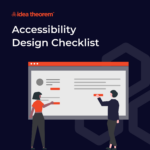In today’s digital age, government services are increasingly shifting online, providing citizens with convenient access to essential services, information, and resources. However, for these services to be truly effective and inclusive, they need to be designed with the end-users in mind. User-centered design, often referred to as User Experience (UX) design, plays a pivotal role in ensuring government services are accessible, transparent, and efficient for all citizens. In this blog, we’ll explore the impact of user-centered design on government services, and how UI/UX strategies can optimize citizen interactions with government platforms.
User-Centered Design in Government

User-centered design is a design approach that prioritizes the needs, preferences, and experiences of the end-users. When applied to government services, it can transform the way citizens interact with public agencies and access vital information. Here’s how:
- Accessibility: One of the primary benefits of user-centered design is increased accessibility. By considering the diverse needs of all users, including those with disabilities, governments can create digital platforms that are compliant with accessibility standards (like WCAG) and ensure that every citizen can access and use government services without barriers. For example, providing text-to-speech options or alternative text for images can make a significant difference for individuals with visual impairments.
- Transparency: User-centered design encourages clear and transparent communication between the government and its citizens. Information is presented in an intuitive and understandable manner, reducing confusion and misinformation. Citizens can easily find the information they need, understand government policies, and make informed decisions.
- Efficiency: By simplifying complex processes and reducing the number of steps required to access government services, user-centered design enhances efficiency. This not only saves time and resources for both citizens and government agencies but also reduces the risk of errors, ensuring that services are delivered accurately and on time.
UI/UX Strategies for Government Services
- User Research: Understanding the needs and pain points of citizens is the foundation of user-centered design. User research involves surveys, interviews, and usability testing to gather insights and create personas that represent the target audience. This information guides the design process.
- Intuitive Navigation: Government websites and applications should be easy to navigate. Clear menus, logical organization, and well-designed search functionalities make it simple for citizens to find the information they need or complete necessary transactions.
- Responsive Design: With the increasing use of mobile devices, responsive design is crucial. Government services should be accessible on various screen sizes, ensuring that all citizens can access information and services from their preferred devices.
- Feedback Mechanisms: Including feedback forms and contact information for government agencies allows citizens to report issues, ask questions, or provide suggestions. Responsive feedback mechanisms demonstrate a government’s commitment to continuous improvement.
- Streamlined Processes: Complex processes can be daunting for citizens. UI/UX designers work to simplify workflows, reducing the number of steps and making government services more user-friendly.
- Data Security: While optimizing user experiences, it’s essential to maintain strong data security measures. Citizens need to trust that their personal information is safe when interacting with government platforms.
The Impact of User-Centered Design

Enhanced Citizen Engagement
User-centered design fosters better citizen engagement. When citizens find government services user-friendly and efficient, they are more likely to actively participate in civic activities. They are more inclined to vote, provide feedback, and take part in community initiatives. By improving UX, government agencies can strengthen their relationship with the public, ultimately leading to a more engaged and informed citizenry.
Inclusivity and Social Equity
Inclusivity is a fundamental aspect of user-centered design. It ensures that government services cater to a wide range of demographics, including those with varying levels of digital literacy. Moreover, it can bridge the digital divide by providing accessible options for those without reliable internet access. Through user-centered design, governments can promote social equity and make sure no one is left behind in the digital age.
Reducing the Burden on Support Services
A well-designed user interface minimizes the need for assistance and support services. When citizens can easily navigate a government website or app, they are less likely to rely on costly call centers or in-person visits. This reduces the strain on government resources and frees up personnel to focus on more complex issues or critical services.
Additional UI/UX Strategies:
Multilingual Support
In multicultural societies, providing services in multiple languages is essential. Multilingual support ensures that non-native speakers and immigrants can access government services with ease. Effective translation and localization are key elements of user-centered design for government.
Personalization
Government platforms can benefit from personalization features that adapt content and services based on the user’s preferences and history. This customization can significantly improve the user experience by offering citizens content that is relevant to their needs and interests.
Education and Training
Incorporate user guides, video tutorials, and tooltips within the platform to educate citizens about how to effectively use government services. By investing in user education, governments can empower their citizens to make the most of digital resources.
Usability Testing and Iteration
Continual improvement is at the core of user-centered design. Governments should regularly conduct usability testing to identify pain points and areas for improvement. This feedback-driven process ensures that the user experience is consistently refined and enhanced.
In Conclusion

Incorporating user-centered design into government services is an ongoing commitment to meeting the needs of a diverse and dynamic citizenry. It’s not just a one-time design effort but a continuous process of improvement. Government agencies that prioritize UX design reap numerous benefits, including higher citizen satisfaction, increased efficiency, better engagement, and a more inclusive society.
As technology continues to advance, governments must adapt and evolve their digital interfaces and services to ensure they remain relevant and accessible to all. By putting citizens at the center of their design and delivery process, governments can achieve their ultimate goal of providing accessible, transparent, and efficient services for everyone, making government services truly “Inclusive by Design.”
—
What’s Next
Idea Theorem is an award-winning design & development agency based in North America. Through our empathy-driven approach, we have crafted digital products that have positively impacted over 10 million users. Our mission is to shape the digital future by delivering exceptional experiences. Contact Us if you have any questions; we will gladly help you.






